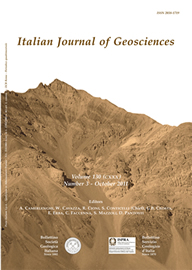
Geological evolution of a complex basaltic stratovolcano: Mount Etna, Italy
Stefano Branca(*), Mauro Coltelli(*) & Gianluca Groppelli(**)
(*) Istituto Nazionale di Geofisica e Vulcanologia, Osservatorio Etneo, sezione Catania, Piazza Roma, 2 - 95123 Catania (Italy). Corresponding authors: phone: +390957165800; e_mail: stefano.branca@ct.ingv.it
(**) C.N.R - Istituto per la Dinamica dei Processi Ambientali,sezione di Milano, Via Mangiagalli, 34 - 20133 Milano (Italy).
Volume: 130 (2011) f.3
Pages: 306-317
Abstract
An updated geological evolution model is presented for the composite basaltic stratovolcano of Mount Etna. It was developed on the basis of the stratigraphic setting proposed in the new geological map that was constrained by 40Ar/39Ar age determinations. Unconformity bounded stratigraphy allows highlighting four main evolutionary phases of eruptive activity in the Etna region. The Basal Tholeiitic Supersynthem corresponds to a period, from about 500 to 330 ka, of scattered fissure-type eruptions occurring initially in the foredeep basin and then in a subaerial environment. From about 220 ka, an increase in the eruptive activity built a lava-shield during the Timpe Supersynthem. The central-type activity occurred at least 110 ka ago through the Valle del Bove Supersynthem. The earliest volcanic centres recognized are Tarderia, Rocche and Trifoglietto and later Monte Cerasa, Giannicola, Salifizio and Cuvigghiuni. During the Stratovolcano Supersynthem, from about 57 ka ago, the intense eruptive activity of Ellittico volcano formed a roughly 3600 m-high stratocone that expanded laterally, filling the Alcantara and Simeto paleovalleys.
Finally, effusive activity of the last 15 ka built the Mongibello volcano. Its eruptive activity is mainly concentrated in three weakness zones in which the recurrent magma intrusion generates flank eruptions down to low altitude. The four main evolutionary phases may furnish constraints to future models on the origin of Etna volcano and help unravel the geodynamic puzzle of eastern Sicily.
Keywords
Get Full Text